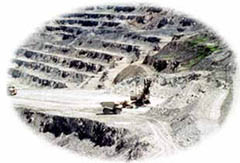|
|

DANGEROUS MEGA MINE THREATENED TATSHENSHINI'S WORLD CLASS WILDERNESS
|
|
In the late 1980s Tatshenshini was threatened by one of the most dangerous mining projects ever proposed in North America. Geddes Resources, a Canadian company, had found a major copper deposit on Windy Craggy Mountain in the center of the wilderness area. 
This mountain was located above the Alsek River, north of that river's confluence with the Tatshenshini river, and only 24 km (15 mi) upstream of Alaska's Glacier Bay National Park, a UN World Heritage Site. Here Geddes planned to rip the top off the 1800 meter (6,000 foot) peak and transform it into an enormous open-pit copper mine.
This mega-project would have had a monstrous impact. The proposed 27, 000 tonne (30,000 ton) per day operation would require a gaping 4 km (2.5 mi) long hole, a 100 meter (350 foot) high tailings dam, a 500 person town site, 240 km (150 mi) of slurry ore and fuel pipelines, as well as a 110 km (70 mi) long road. The infrastructure alone would devastate Tatshenshini's world-class wilderness, but to make matters worse, the proposed mine had a massive potential for acid mine drainage and heavy metal pollution which could poison the international river system, devastating salmon, bear, wolf, eagle, and all other wildlife populations.
|
"The pristine Tatshenshini-Alsek was threated in the late 1980s by a proposal to build one of the most dangerous mining projects ever undertaken in North America."
|
|
Because the ore at Windy Craggy is 35 percent sulfide, huge amounts of sulfuric acid (the same acid used in car batteries) would be generated if this rock were exposed to atmospheric oxygen and water vapor through mining. Once the acid got into the bedrock, heavy metals could then be leached out. Called acid mine drainage (AMD), this toxic, acid-heavy metal combination is lethal to fish. There is no technology that can stop acid mine drainage once it begins; it is an irreversible chemical reaction that continues for thousands of years. Even today, mines that operated 2,000 years ago in Roman England still bleed red acid mine drainage into streams.
In the case of the Windy Craggy proposal, given the extraordinarily high level of sulfide in the ore, Canadian and American government scientists had confirmed the likelihood that the pristine Tatshenshini-Alsek river system, both in British Columbia and Alaska, could be poisoned for thousands of years. If such a calamity happened, the salmon runs would be devastated forever, as would be the grizzlies, the eagles, and Native peoples dependent on them. In effect, Geddes's project meant risking such perpetual destruction in exchange for a mere 15 years of mining.
|
"The idea of a mining company saying that it could plan for time period twice the age of the Pyramids was absurd, to say the least."
|
|
To deal with all these apparent dangers, the company proposed to submerge underwater, behind huge earth dams, the 375 million tons of acid generating waste rock and mill tailings that the mine would produce. The company said this would stop oxygen in the air from mixing with the sulfide, thus preventing the acid chemical reaction. However, the company's solution was fatally flawed.
The prevention of the poisoning process meant that Geddes's dams would have to operate fail-safe for 10,000 years without allowing the water to leak out and expose the sulfide rock. The idea of a mining company saying that it could plan for time period twice the age of the Pyramids was absurd, to say the least. Indeed, given the Tatshenshini region's extreme earthquake hazard, no one, and certainly not Geddes, could guarantee that the tailings dam would remain intact for 10 years, let alone 10,000. In short, the company's plans looked dangerously irresponsible.
|
"Even today, mines that operated 2,000 years ago in Roman England still bleed red acid mine drainage into streams."
|
|
Quite simply, the Windy Craggy mind had the makings for a transboundary environmental disaster on a monumental scale, one that could result in a major international environmental conflict between Canada and the United States. After all, major American interests were at risk; Alaska's Glacier Bay National Park, the livelihood of the Yakutat and Chilkat people, and a commercial salmon fishery worth $50 million each year all depend on the Tatshenshini-Alsek River system. The proposed mine directly threatened American territory, fisheries, Native populations, and a first-class national park. And so in the Tatshenshini region an epic environmental showdown arose.
|
|
Back to Tatshenshini-Alsek Park Mainpage
Become Involved!
|
|

